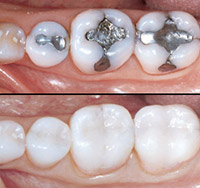Definition
By Anusavice

Above : Conventional Silver Filling . Below : Tooth Coloured Composite
Composite – in material science, a solid formed from two or more distinct phases (e.g. particles in a metal phase) that have been combined to produce properties superior to or intermediate to those of the individual constituents
Dental composite is defined as a highly cross-linked polymeric material reinforced by a dispersion of amorphous silica, glass, crystalline, or organic resin filler particles and/or short fibers bonded to the matrix by a coupling agent
Indications
Class I, II, III, IV, V, VI
Core buildups
Sealants and preventive resin restorations
Esthetic enhancement procedures
Veneering metal crowns/bridges
Periodontal splinting
Non-carious lesions
Enamel hypoplasia
Composite inlays and onlays
Repair of old composite /ceramic restorations
Patients allergic to metals
Contraindications
Isolation
Occlusion
Subgingival area/root surface
Poor oral hygiene
High caries index
Habits (bruxism)
Operator abilities
Advantages
Esthetics
Conservation of tooth structure
Less complex when preparing the tooth
Insulative
Used almost universally
Strengthening ( Bonds to tooth structure )
Repairable
No corrosion
Disadvantages
Polymerization shrinkage
Technique sensitive
Higher coefficient of thermal expansion
Difficult time consuming
Increased occlusal wear
Low modulus of elasticity
Staining
Costly
Chemically activated resins
Synonyms- self curing
Supplied as two pastes
When the two pastes are spatulated, the amine reacts with the Benzoylperoxide to form free radicals and polymerization is initiated.
Advantages –
Even polymerization throughout the restoration
Disadvantages –
Impossible to avoid incorporation of air into the mix forms pores and weakens the structure.
Oxygen inhibition of polymerization during curing
No control over the working time
Both insertion and contouring must be completed quickly once the resin components are mixed and placed into the cavity
Light-cured composites
Developed To overcome the problems of chemical activation
The first light activated systems were formulated for UV light to initiate free radicals. Today, the UV light is replaced by visible blue light-activated systems
Light curable composites are supplied as a single paste contained in a light-proof syringe
The free radical initiating system, consists of a photosensitizer(Camphorquinone (CQ) – absorbs blue light with wavelengths between 400 and 500nm and an amine initiator, is contained in this paste (Dimethylaminoethylmethacrylate (DMAEMA) in case of visible light and Benzoylmethylether in case of UV light polymerization)
 Advantages –
Easy to use, single paste system
Less porosity
Color stability
Command polymerization
Allow operator to complete insertion and contouring before curing is initiated
They are not as sensitive to oxygen inhibition as the chemical cured systems
Better mechanical properties
Setting time – faster cure; an exposure of 40 seconds or less is required to light cure a 2mm thick layer.
Disadvantages –
They must be applied incrementally when the bulk exceeds approx. 2 – 3mm
Limited depth of light penetration
Time consuming
Relatively poor accessibility in certain posterior and interproximal locations
Variable exposure times because of shade differences, resulting in longer exposure times for darker shades and/or increased opacity
Sensitivity to ambient light – leads to formation of a skin or crust when an opened tube is exposed
Cost of the light curing unit is expensive
Shrinkage towards light source
Ocular damage – can cause retinal damage if one looks directly at the beam.
Dual-cure resins
Consists of two light curable pastes, one containing benzoyl peroxide and the other paste containing the aromatic tertiary amine.
When these two pastes are mixed and then exposed to light, light curing is promoted by the amine/CQ combination and the chemical curing is promoted by the amine/BP interaction
Extraoral curing
Used to promote higher level of cure
Used mainly for inlays
A heat of 150oC for 1 hour is employed.
UV light curing system
Early 1970s – as Nuva light (Dentsply/Caulk).
Works at 360 to 400nm range
Disadvantages –
Because of spectral distribution of UV light, it may cause damage to eye and soft tissue burns
Depth of cure achieved was less
Lack of penetration through tooth structure
Possibility of selectively altering the oral flora of the patient’s mouth.
Quartz-tungsten halogen lamps:-
Have a quartz bulb with a tungsten filament that irradiates both UV and white light
Minimum output should never drop below 300mW/cm2
Wavelength varies among the units from 450 to 490nm
Advantages of the QTH:-
Cost is less than the other light systems
They generate little or no heat
They are time proven
They offer a faster resin cure
Disadvantages of the QTHÂ
They have a slower cure time (about 15 sec) than PAC lights (about 3 sec) or some LED lights (a range of 10 to 20 sec)
The units are relatively large and cumbersome
The bulbs decrease in output over a period of time
Some brands have a narrow-diameter light guide (curing tip) than conventional lights
